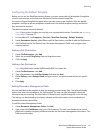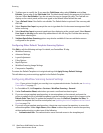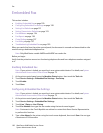Scanning
WorkCentre 6400 Multifunction Printer
System Administrator Guide
116
Scanning to a User’s Home Folder
The Scan to Home feature allows users to scan to their home folder as defined in your LDAP directory,
or to a shared folder on the network.
Before you begin:
• Enable Workflow Scanning. For details, see Configuring Workflow Scanning on page 106.
• Configure Network Authentication. The authentication server and the server that you are
scanning to must have the same domain. For details, see Network Authentication on page 56.
If you want to scan to the home folder defined in an LDAP directory:
• LDAP server settings must be configured. For details, see LDAP on page 37.
• Each user's home folder location must be defined in the LDAP directory.
If you want to scan to a shared folder on the network, create a shared folder on your network with read
and write access privileges.
Configuring Scan to Home
Note: If your printer is locked, you must log in as a system administrator. For details, see Accessing
CentreWare IS on page 17.
1. In CentreWare IS, click Properties > Services > Scan to Home > General.
2. Under Status, click Enabled.
3. Type a Friendly Name up to 127 characters in length. This is the default description of the
template that displays for users when scanning at the control panel.
4. Type a Template Name up to 127 characters. This is the default name that displays for users
when scanning at the control panel. If you leave this field blank, the template will be named
@S2HOME.
5. To scan to the home folder defined in an LDAP directory:
a. Select LDAP Query.
b. To check your LDAP mapping settings, click LDAP Mapping for Home Directory. For details,
see Defining User Mappings on page 38.
6. To scan to a shared network folder:
a. Select No LDAP Query.
b. In the Network Home Path field, type the complete network path of the external server
where scanned image files will be stored. Example: \\servername\foldername.
7. To create a subdirectory in the network home path, select Automatically create Subdirectory and
type a name in the Subdirectory name field.
8. If your network home directory path structure includes folders named according to each user’s
user name, for example \\servername\foldername\username. and you want to store scanned
images in these folders, select Append User Name to Path. The user name is the name used when
logging in at the control panel.
9. If you want to create individual folders for each user, select Automatically Create User Name
directory if one does not exist. Example: \\servername\foldername\username.
10. Click Apply.


















